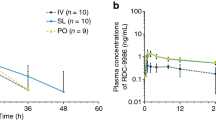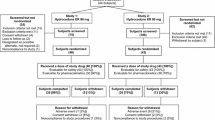Abstract
Purpose. To test the hypothesis that the pharmacokinetics of d-meth- ylphenidate (d-MPH) would be altered by food ingested before administration of an immediate release formulation (dl-MPH- IR) but not when food is ingested before a slow release formulation (dl-MPH-SR).
Methods. A randomized, four-phase, open label, crossover design was conducted in 24 healthy men who each received, on separate occasions, dl-MPH-IR and dl-MPH-SR taken after an overnight fast and 15 min after a standardized breakfast (20% protein, 21% fat, 59% carbohydrate). Plasma MPH levels were monitored by a validated, stereoselective, GLC-ECD method.
Results. For plasma d-MPH, there were significant differences (ANOVA) between dl-MPH-IR and dl-MPH-SR in tmax, Cmax (peak exposure), and Cmax/AUC (sensitive to rate of absorption). Dl-MPH-SR on average delayed tmax from 2.3 to 3.7 h and lowered Cmax 34%. There was no significant difference between the formulations in AUC (extent of absorption). For dl-MPH-IR, food significantly increased Cmax (23%) and AUC (15%) and for dl-MPH-SR the corresponding increases were Cmax (17%) and AUC (14%). After dl-MPH-IR, food delayed average tmax from 2.0 to 2.5 but had no effect on tmax after dl-MPH-SR. There was no effect of food on Cmax/AUC (rate of absorption).
Conclusions. Food caused a significant increase in extent of absorption but had no effect on rate of absorption of d-MPH after either dl-MPHIR or dl-MPH-SR.
Similar content being viewed by others
REFERENCES
N. Srinivas, J. Hubbard, E. Korchinski, and K. Midha. Stereoselective urinary pharmacokinetics of dl-threo-methylphenidate and its major metabolite in humans. J. Pharm. Sci. 81:747-749 (1992).
N. Srinivas, J. Hubbard, E. Korchinski, and K. Midha. Enantioselective pharmacokinetics of dl-threo-methylphenidate in humans. Pharm. Res. 10:14-21 (1993).
T. Aoyoma, H. Kotaki, Y. Honda, and F. Nakagawa. Kinetic-analysis of enantiomers of threo-methylphenidate and its metabolite after oral administration as determined by a gas chromatographic-mass spectrometric method. J. Pharm. Sci. 79:465-469 (1990).
N. Srinivas, J. Hubbard, D. Quinn, and K. Midha. Enantioselective pharmacokinetics and pharmacodynamics of dl-threo-methylphenidate in children with attention deficit hyperactivity disorder. Clin. Pharmacol. Ther. 52:561-568 (1992).
B. Faraj, Z. Istraili, J. Perel, M. Jenkins, S. Holtzman, S. Cucinell, and P. Dayton. Metabolism and disposition of methylphenidate-14C: studies in man and animals. J. Pharmacol. Exp. Ther. 191:535-547 (1974).
C. L. DeVane, J. S. Markowitz, S. W. Carson, D. W. Boulton, H. S. Gill, Z. Nahas, and S. C. Risch. Single-dose pharmacokinetics of methylphenidate in CYP2D6 extensive and poor metabolizers. J. Clin. Psychopharmacol. 20:347-349 (2000).
R. Yoss and D. Daly. On the treatment of narcolepsy. Med. Clin. North Am. 52:781-787 (1968).
L. Oettinger and L. Majovshi. Methylphenidate: A review. South. Med. J. 69:161-163 (1976).
Y.-P. Chan, J. Swanson, S. Soldin, J. Theissen, S. Macleod, and W. Logan. Methylphenidate hydrochloride given with or before breakfast. II. Effects on plasma concentration of methylphenidate and ritalinic acid. Pediatrics 72:56-59 (1983).
C. Gualtieri, W. Wargin, R. Kanoy, W. Youngblood, and G. Breese. The effects of fasting and eating on the absorption of methylphenidate. Res. Commun. Psychol. Psychiatry Behav. 7:381-384 (1982).
K. Patrick, A. Straughn, E. Jarvi, G. Breese, and M. Meyer. The absorption of sustained-release methylphenidate formulations compared to an immediate-release formulation. Biopharm. Drug Dispos. 10:165-171 (1989).
N. B. Modi, B. Wang, W. T. Hu, and S. K. Gupta. Effect of food on the pharmacokinetics of osmotic controlled-release methylphenidate HCl in healthy subjects. Biopharm. Drug Dispos. 21:23-31 (2000).
N. Srinivas, D. Quinn, J. Hubbard, and K. Midha. Stereoselective disposition of methylphenidate in children with attention deficit disorder. J. Pharmacol. Exp. Ther. 241:300-306 (1987).
B. Singh. Effects of food on clinical pharmacokinetics. Clin. Pharmacokinet. 37:213-255 (1999).
M. Modi, J. Hassett, and D. Lalka. Influence of posture on hepatic perfusion and the presystemic biotransformation of propranolol: simulation of the food effect. Clin. Pharmacol. Ther. 44:268-274 (1988).
H. Semple and F. Xia. Interaction between propranolol and amino acids in the single-pass isolated, perfused rat liver. Drug Metab. Dispos. 23:794-798 (1995).
H. Leidholm and A. Melander. Concomitant food intake can increase the bioavailability of propranolol by transient inhibition of its presystemic primary conjugation. Clin. Pharmacol. Ther. 40:29-36 (1986).
T. Walle, T. Fagan, U. Walle, M. Oexmann, E. Conradi, and T. Gaffney. Food induced increase in propranolol bioavailability: relationship to protein and effects on metabolites. Clin. Pharmacol. Ther. 30:790-795 (1981).
C. Svensson, P. Mauriello, S. Barde, E. Middleton, and D. Lalka. Effect of carbohydrate on estimated hepatic blood flow. Clin. Pharmacol. Ther. 35:660-665 (1984).
J. Power, D. Morgan, and A. McLean. Effect of sensory (teasing) exposure to food on oral propranolol bioavailability. Biopharm. Drug Dispos. 16:579-589 (1995).
L. Endrenyi, S. Fritsch, and W. Yan. Cmax/AUC is a clearer measure than Cmax for absorption rates in investigations of bioequivalence. Int. J. Clin. Pharmacol. Ther. Toxicol. 29:394-399 (1991).
L. Endrenyi and W. Yan. Variation of Cmax and Cmax/AUC in investigations of bioequivalence. Int. J. Clin. Pharmacol. Ther. Toxicol. 31:184-189 (1993).
R. Rosse and W. Licamele. Slow release methylphenidate: problems when children chew tablets. J. Clin. Psychiatry 48:525.
Author information
Authors and Affiliations
Rights and permissions
About this article
Cite this article
Midha, K.K., McKay, G., Rawson, M.J. et al. Effects of Food on the Pharmacokinetics of Methylphenidate. Pharm Res 18, 1185–1189 (2001). https://doi.org/10.1023/A:1010987212724
Issue Date:
DOI: https://doi.org/10.1023/A:1010987212724




